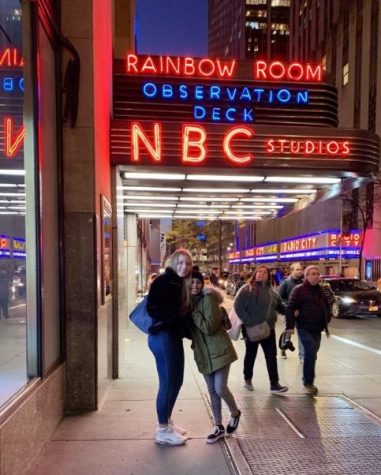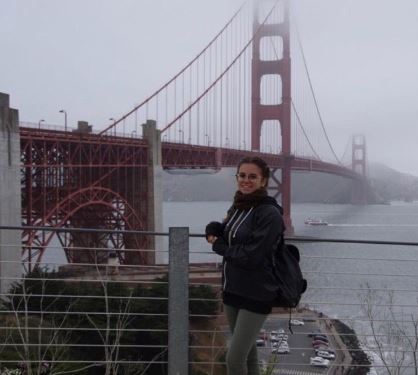Exchange Students Contemplate Contrasting Educational Systems
This year, the foreign exchange program has brought some more diversity to the Liberty High School community. The foreign exchange students for this school year are: Gaia Giombetti (from Italy), Anna Urbanski (from France), Alba De Sande Lopez (from Spain), and Erik Hannemann, Sophie Preuβ, and Salma Hussen (all from Germany). All the exchange students Liberty has, have come from a whole different part of the world and it shows how in every country there is a different educational system in place other than what America has.

Sophie Preuß visited New York City with her host family.
Students here, in most places, go to school for about 8 hours a day, for 5 days a week, sometimes 6 depending on if they have to attend Saturday school. Students in foreign countries go to school for shorter amounts of time and there are more breaks and for about 5 days a week.
“In Italy we go to school for 5 hours from 8:10 a.m. through 1 p.m. We study a lot, like, 60 pages a day, and we have a lot of tests. We don’t have the cafeteria, but we have a snack bar,” said senior Gaia Giombetti.
“A normal school day in France starts by taking the bus, which are not yellow! Then school starts at 8 a.m., followed by a 1 hour lunch break, and the day ends at 5 p.m. We are allowed to leave the school and go out to eat with friends during our lunch break,” said senior Anna Urbanski.
“Our school starts at 8:25 a.m. and finishes at 2:30 p.m. We have 2 breaks, a 15 minute one at 10:30 a.m. and a 25 minute on at 12:30 p.m. Our classes are an hour long and we don’t eat lunch at school, and we arrive home around 3:00 p.m,” said senior Alba De Sande Lopez.
“So a normal school day would be from 7:30 a.m. to 3:10 p.m. With 8 different subjects, after school you go home or you can do sports (but not in a team from school),” said senior Sophie Preuβ
“My school day starts at 8:05 a.m. and ends for me at 3:35 p.m. Our lessons are 90 minutes long and between every lesson is a 20 minute break and between the 3rd and 4th block is an hour break for lunch,” said senior Erik Hannemann.
The activities and schooling for these students aren’t typically things American schools offer. Foreign schools run late into the afternoon, in most places, so sports and clubs after school aren’t common. The only time sports are able to be played are if schools let out early in the afternoon, but even then there are no school teams in most countries.
“Our activities are very different because we have a lot of types of school, like

Gaia Giombetti stand in front of the Golden Gate Bridge located in San Francisco, CA.
the Classic School, the Science School, the Language School, the Tourism School, the Restaurant/Cook School. I do the Tourism School and I have 13 subjects, like Economics, Law, Languages, and Geographic which are the classic subjects,” said Giombetti.
“Unfortunately, we don’t have any sport clubs because school ends very late compared to America! However, every Wednesday is a half day, that lets me do dance classes and pottery. We are not really able to choose our classes except for the language. English, French, science, and maths are 50 minutes. Spanish, History, music, and arts are also 50 minutes,” said Urbanski.
“School in America is so much different than in Germany. We can’t choose our subjects. Every year, we have to do the same subjects. We do not have the opportunity to learn about sports marketing or psychology. We also have stricter rules, like we can’t use our phone in class. The teaching in Germany is totally different than here,” said Salma Hussen.
“Schools in Spain don’t usually have extracurricular activities and when they do, very few people join them. We do take part in clubs, but they are often outside school. The most popular activity for boys is soccer and for girls is dancing and/or swimming. We don’t get to choose our subjects and we take the same classes all year long. We are assigned a class every year and we stay with that group for every class in the same room. The teachers are the ones who change rooms. We have 11 classes and our schedule changes everyday,” said De Sande Lopez.
“Germany schools don’t have any sport teams to represent their school. So we only go to school and we have different classes everyday. Chemistry, biology, maths, physics, German, English, history, politics, geography, technology, a third language (you can choose French, Latin, or Spanish), PE, art, and music are classes everybody have to take in a year. You can choose between psychology, a fourth language, or information about computers,” said Preuβ.
“In Germany, school is very different than in America. In Germany we don’t have the same subject everyday and we don’t have electives. We can’t choose our subjects and you have to take all subjects like chemistry, biology, physics, history, and geography. You can’t choose from them. Also, there is no middle school in Germany. Only elementary (1st to 4th grade) and high school (5th to 12th grade),” said Hannemann.

Anna Urbanski went on her government class field trip to tour the Capitol.
Other countries also go to school and have breaks at different times than American schools. American schools typically get 3-5 days for Thanksgiving break, about 2 weeks of Winter break, Martin Luther King Jr. day, President’s day, about a week for Spring break, Memorial Day, and about 2 months worth of Summer break.
“School starts in September and ends in July. There are 5 big holidays between all these months: Fall for 2 weeks, Christmas for 2 weeks, February for 2 weeks, April for 2 weeks, and Summer for 2 months,” said Urbanski
“The school year is mostly 10 months with breaks throughout the year,” said Hussen
Schools in foreign countries have similarities but the education system in these specific countries that Liberty is hosting this year for the foreign exchange program, is completely different from the average schooling they are used to.






Tara • Mar 10, 2020 at 1:57 pm
great article!
Grace Derby • Feb 10, 2020 at 1:03 pm
I like that they have shorter days and where they come form. But I like lunch to much to do it myself.